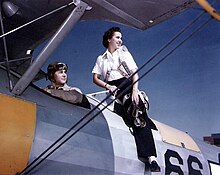Boeing-Stearman Model 75
In the immediate postwar years, they became popular as crop dusters and sports planes, and for aerobatic and wing walking use in air shows.Able to withstand +12g and -9g, the aircraft was powered by a 210-hp Lycoming R-680, first flew on 1 January 1934, before flight tests were conducted at Wright Field, Naval Air Station Anacostia, and Pensacola.[3]: 145–148, 168 The Kaydet was a conventional biplane of rugged construction, with a large, fixed tailwheel undercarriage, and accommodation for the student and instructor in open cockpits in tandem.A popular approved modification to increase the maximum takeoff weight and climb performance involved fitting a larger Pratt & Whitney R-985 Wasp Junior engine and a constant-speed propeller.Data from United States Military Aircraft since 1909[116]General characteristics Performance An iconic movie image is a Stearman cropduster chasing Cary Grant across a field in North by Northwest (the airplane that chased Grant was actually a Naval Aircraft Factory N3N Canary; the plane that hits the truck is a Stearman).
















ManufacturerStearman AircraftBoeingAmerican Airmotive NA-75biplanetrainer aircraftUnited StatessubsidiaryUnited States Army Air ForcesUnited States NavyRoyal Canadian Air ForceWorld War IIcrop dustersaerobaticwing walkingair showsNAS Corpus Christi, 1943NAS Pensacola Flight SchoolBreitling SADirgantara Mandala MuseumNAS Corpus ChristiMuseum of AviationRobins AFBAeronautics Museum of MaracayLloyd Stearmancantilevertrim tabsLycoming R-680Wright FieldNaval Air Station AnacostiaPhilippine Army Air CorpsType CertificateParks College of Engineering, Aviation and TechnologycockpitsPratt & Whitney R-985 Wasp Juniorconstant-speed propellerContinental R-670Jacobs R-755Lend-LeaseWright J-5/R-790 WhirlwindCuban Air ForceWright R-790 WhirlwindArgentinaArgentine Air ForceArgentine NavyBoliviaBolivian Air ForceBrazilBrazilian Air ForceCanadaRepublic of ChinaRepublic of China Air ForceColombiaColombian Air ForceDominican RepublicDominican Air ForceGreeceHellenic Air ForceGuatemalaGuatemalan Air ForceHondurasHonduran Air ForceIsraelIsraeli Air ForceMexicoMexican Air ForceNicaraguaNicaraguan Air ForceParaguayParaguayan Air ForcePeruvian Air ForcePhilippinesPhilippine Air ForceUnited States Army Air CorpsUnited States Marine CorpsVenezuelaVenezuelan Air ForceYugoslaviaYugoslav Air ForcewarbirdBahía Blanca, Buenos AiresHangar-7SalzburgMuseu AeroespacialRio de JaneiroTAM MuseumSão Carlos, São PauloCanadian Warplane Heritage MuseumHamilton, OntarioLacombe, AlbertaCollingwood, OntarioReynolds-Alberta MuseumWetaskiwin, AlbertaSarnia, OntarioWhitehorse, YukonHafnarfjörður, Capital RegionUSS WaspYogyakartaTaloa Academy of AeronauticsIsraeli Air Force MuseumHatzerimSanta Lucía, ZumpangoOostwold AirportBreda International AirportTexel International AirportArdmore, AucklandMilfordBlenheimHastingsPukekoheMount MaunganuiCuatro Vientos, MadridAltenrheinStadler RailGangshan District, Kaohsiung CityArkansas Air & Military MuseumFayetteville, ArkansasAir ZooCavanaugh Flight MuseumCollege Park Aviation MuseumWestern Antique Aeroplane & Automobile MuseumHood River, OregonMuseum of FlightSeattle, WashingtonUS Army Aviation MuseumFort Novosel, Alabama